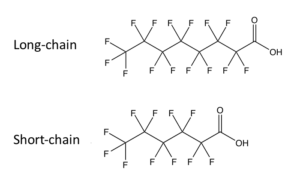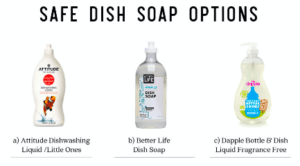April 2018: 25 Senators making a difference
In this edition:
- Harmful flame retardant standard — Defeated!
- German and U.S. EPA concerned about “environmentally friendly” alternatives
- Inspiration: 2018 Goldman Environmental Awards
- “Because Health” for Healthy Choices
- It’s Not Easy Being Green
The hills are green, colorful wildflowers are blooming, and I am back from a lecture/workshoptrip to five cities. I shared the Six Classes concept for reduced toxics and a healthier world at the Chemistry Dept., University of Toronto, Canada; Health Canada in Ottawa; Harvard University and Harvard Hospitals in Boston; and in New York City and Albuquerque, I shared the Six Classes concept for reduced toxics and a healthier world.
I have other good news, discussed below regarding reducing harm from the classes highly fluorinated chemicals (called PFAS or PFC) and flame retardants.

With regard to the class of highly
fluorinated stain and water repellant chemicals, substances containing eight carbons (C8) were phased out in 2015 due to their toxicity and extreme persistence. However numerous replacements now in use such as C6, are similar in structure and may cause similar harm. We believe all PFAS–including the “short chain” alternatives–should be avoided unless their function is essential and also that it is critical to consider the whole class of PFAS. And 25 U.S. Senators are doing just that!
A recent letter to the EPA, signed by the 25 Senators, called for the EPA to set a Maximum Contaminant Level (MCL) for all PFAS. This would mean our nation’s drinking water would be required to be monitored and contaminated water would need to be cleaned up to that level. The result: healthier drinking water for millions of Americans.This is very promising. As we have long been educating Hill staff and others on the importance of taking action on the entire class of PFAS, not just the phased out substances, we are delighted to see the chemical class concept in the Senators’ letter.
Read on for good news from Tom Bruton, our in-house expert on PFAS, about the German EPA and the US EPA beginning to take action on the short chain replacement PFAS and other news on keeping unneeded flame retardants out of our furniture.
And Monday’s New York Times has an excellent oped by Sharon Lerner about “How States are doing what Scott Pruit won’t” regarding this class of chemicals.
On another happy note, the Green Science Policy team enjoyed the inspiring Goldman Environmental Awards this week.
Happy spring,
Arlene
Harmful flame retardant standard — Defeated!

The demise of NFPA 277 is a huge relief after our decade of work so flame retardants are no longer needed in furniture across the US. However, continued research and an upcoming meeting on furniture fire standards at the Consumer Product Safety Commission are still of concern. We hope the Commission will focus on increasing fire safety by improving smoke detectors, sprinkler systems, and educational campaigns rather than a new open flame standard that could once again bring toxic flame retardants back into our homes and bodies.
German and U.S. EPA concerned about “environmentally friendly” alternatives

The chemical industry has long claimed that following their 2015 phase out of the long-chain highly fluorinated chemicals (PFAS), the short-chain replacement are the “environmentally friendly alternatives.” Given that these short chains are also “forever chemicals” that never break down and the long-history of replacing a toxic chemical with another, many of us are taking these industry claims with a large grain of salt.
Our 2015 Madrid Statement made the scientific case for why all PFAS, both older long- and newer short-chains, should be avoided when possible. Nonetheless, government regulators have focused on the phased-out long-chains, and many product manufacturers are now using short chains with the belief they are doing the right thing.
And now in both Europe and U.S., the EPA is beginning to take action on the short-chains. The German EPA has proposed amendments to REACH to make it easier to restrict short-chain PFAS before they are put on the market. There is also a proposal in the works to add a health limit for all PFAS, as a class, to the EU drinking water regulations. Here in the U.S., the EPA announced that it hopes to issue health advisories for two short-chain PFAS this summer. These developments follow state level actions to stop the use of the entire class of PFAS in firefighting foam, food contact paper, and carpet. This increasing use of the class concept is a cause for optimism.
Inspiration: 2018 Goldman Environmental Awards

On April 23rd, the Goldman Environmental Prize was awarded to seven environmental activists from six continents. Regarded as the Green Nobel Prize, this year’s recipients included a French womanwho ended the very destructive practice of deep sea trawling in the EU, a Colombian woman who stopped illegal mining in her community, a Filipino man who spearheaded a successful campaign to ban lead paint, and an American woman who helped focus the national spotlight on the contamination of drinking water in Flint Michigan.
While the ceremony was joyous, we recalled Berta Caceres and other environmental leaders who have given their lives to preserve the health of our planet, a somber reminder of how much grassroots activists risk.
Congratulations to the incredible winners, you are an inspiration to all!
“Because Health” for Healthy Choices

You might like to check out the newly-launched website Because Health featuring science-based articles, tips, product recommendations, and expert advice for well-informed and healthy lifestyle choices.
“I started Because Health for people who care about wellness and health, and recognize that environmental pollution, toxic chemicals in our products, and climate change, are just as important to our health as working out and eating right,” said Karen Wang, PhD, Founder of Because Health and Director of the Collaborative on Health and the Environment (CHE). “As a working mom, I know it’s impossible to research everything, do it all, and determine what’s scientifically reliable. I want our site to be a place for people who want to make informed choices and advocate for their health.”
Because Health was developed by CHE with the millennial generation in mind, but the short readable science-based articles on this site should be of broad interest.
It’s Not Easy Being Green

Low-income communities frequently face disproportionate exposures to toxic chemicals from nearby highways and industrial sites. Residents have increased risk for cancer, lowered IQ, and asthma. Research has found that building public housing with sustainable materials could decrease exposure to environmental pollutants. However foam plastic building insulation, commonly used in green building for its energy-efficiency, often contains harmful flame retardants.
A recent study from the Silent Spring Institute evaluated residents’ chemical exposures in recently renovated green public housing units. They found high levels of the chlorinated flame retardant TCPP in the air and dust before residents moved in, likely from the building insulation. TCPP is associated with kidney and reproductive disorders in animals, and the recycling of insulation with TCPP can release this harmful chemical in to the soil and water. Despite these concerns, TCPP remains a common flame retardant and is often used in foam plastic building insulation, sometimes upwards of 25% by weight.
The Silent Spring study suggests that building materials may be a source of exposure to problematic chemicals, highlighting that green building certifications should consider lifecycle and health impacts, and not just energy-efficiency, before calling materials green.
Receive Updates By Email
Subscribe to our monthly newsletter and get these updates delivered right to your inbox!